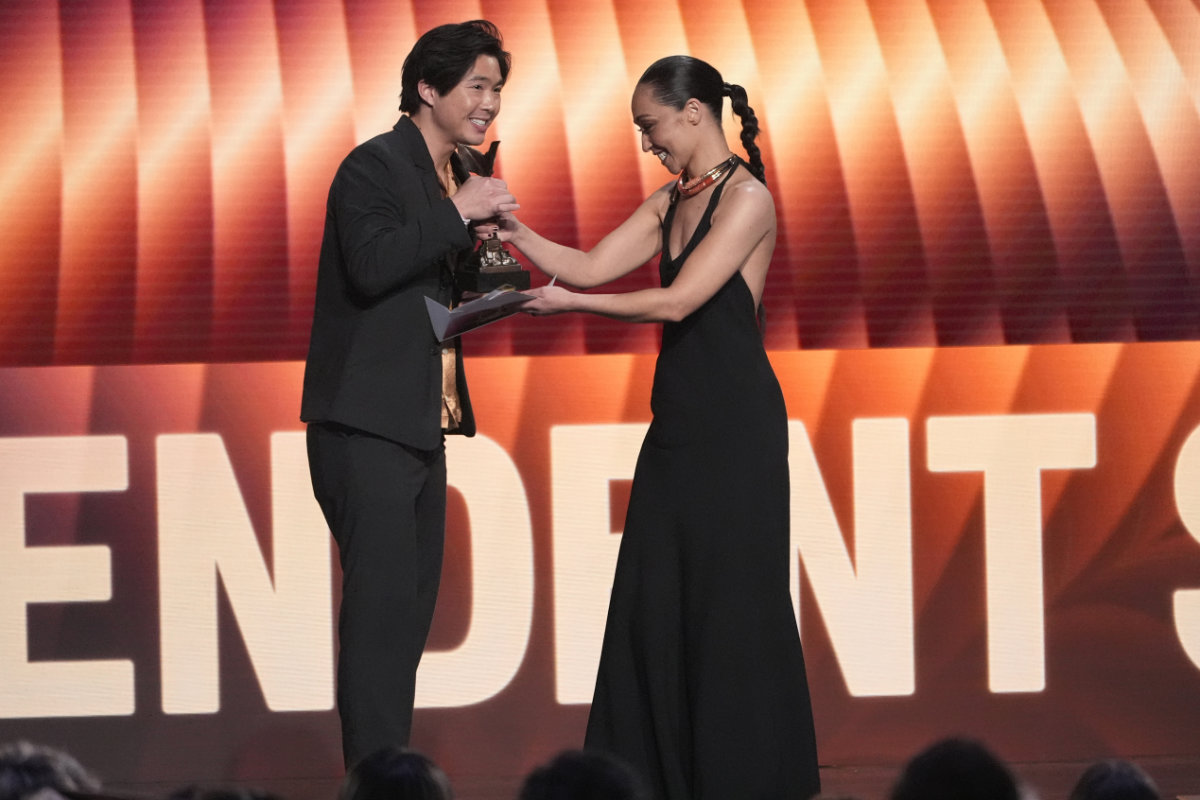Los Angeles: “No Other Land,” the Oscar-nominated film by a Palestinian-Israeli collective about the destruction of a village in the West Bank, has won the documentary prize at the Independent Spirit Awards.
The Spirit Awards, held in a beachside tent in Santa Monica, California, is the shaggier, more irreverent sister to the Academy Awards, celebrating the best in independent film and television.
“No Other Land” was directed by a collective of four Israeli and Palestinian filmmakers — activists Basel Adra, Hamdan Ballal, Yuval Abraham and Rachel Szor — and marks their directorial debut.
The film follows the story of Adra, a young Palestinian activist from Masafer Yatta in the West Bank, as he fights against the mass expulsion of his community by Israeli forces. Since childhood, Adra has documented the demolition of homes and displacement of residents in his region under military occupation.
Meanwhile, Sean Baker’s “Anora” won best film, best director and best actor for Mikey Madison at the Independent Spirit Awards on Saturday in what could be a preview of next Sunday’s Oscars: The film about a Brooklyn sex worker and her whirlwind affair with a Russian oligarch’s son has emerged in recent weeks as an awards season front-runner.
In accepting the directing prize, Baker spoke passionately about the difficulty of making independent films in an industry that is no longer able to fund riskier films. He said indies are in danger of becoming calling card films — movies made only as a means to get hired for bigger projects.
“The system has to change because this is simply unsustainable,” Baker said to enthusiastic applause. “We shouldn’t be barely getting by.”
“Anora’s” best film competition included Jane Schoenbrun’s psychological horror “I Saw the TV Glow,” RaMell Ross’ adaptation of Colson Whitehead’s “Nickel Boys,” Greg Kwedar’s incarceration drama “Sing Sing” and Coralie Fargeat’s body horror “The Substance.”
This year had several other possible Oscar winners celebrating. Kieran Culkin, considered an Oscar favorite, won the supporting performance award for “A Real Pain.” His director, co-star and writer Jesse Eisenberg won best screenplay for the film about two cousins embarking on a Holocaust tour in Poland.
Culkin was not there to accept — he also missed his BAFTA win last weekend to tend to a family member — but other Oscar nominees like Madison and Demi Moore were.
Madison won the top acting prize over Moore at the BAFTAs last weekend, as well, and stopped Saturday to pet Moore’s dog Pilaf on the way to the stage. Acting categories for the Spirit Awards are gender neutral and include 10 spots each, meaning Madison and Moore were up against Oscar nominees like Colman Domingo (“Sing Sing”) and Sebastian Stan (“The Apprentice”).
“Flow,” the wordless animated Latvian cat film, won best international film. At the Oscars, it’s competing in the international film category and animation.
While the Spirit Award winners don’t always sync up with the academy, they can often reflect a growing consensus as in the “Everything Everywhere All At Once” year. The awards limit eligibility to productions with budgets of $30 million or less, meaning more expensive Oscar nominees like “Wicked” and “Dune: Part Two” were not in the running.

Sean Wang, left, accepts the award for best first screenplay for "Didi" from presenter Ruth Negga during the Film Independent Spirit Awards on Feb. 22, 2025, in Santa Monica, California. (AP)
Sean Wang accepted best first feature and best first screenplay prizes for “Dìdi.” He said it was special to be sharing the stage with one of his stars, Joan Chen, who was also nominated for the same award 25 years ago for “Xiu Xiu: The Sent Down Girl.”
The Netflix phenomenon “Baby Reindeer” also picked up several prizes, for actors Richard Gadd, Jessica Gunning and Nava Mau.
Mau, who is trans, spoke about the importance of actors sticking together “as we move into this next chapter.”
“We don’t know what is going to happen, but we do know our power,” Mau said. “We are the people and our labor is everything.”
Other television winners included “Shōgun,” for best new scripted series, and “How to Die Alone,” for best ensemble.
“How to Die Alone” creator and star Natasha Rothwell was emotional while accepting the ensemble prize. The show was recently canceled after its first season.
Rothwell said it was “a show about the need to feel seen, to be valued just as you are.”
“For Black stories, visibility isn’t a privilege: It is a necessity,” Rothwell said. “We deserve to take up space, to be complex, to be hilarious and to be fully human.”

KeiLyn Durrel Jones, Chris Powell, Michelle McLeod, Natasha Rothwell, Jaylee Hamidi, Elle Lorraine and Arkie Kandola, after receiving the Best Ensemble Cast award for "How to Die Alone" in the 40th Film Independent Spirit Awards. (REUTERS)
The generally lighthearted show took a moment to acknowledge the impact of the wildfires on Los Angeles. Bryant made a plea to anyone watching the show, in the audience or on the YouTube livestream, to help rebuild L.A. She pointed to a QR code that appeared on the livestream to make donations to the Film Independent Emergency Filmmaker Relief Fund, providing grants to alumni impacted by the wildfires.
The show also paid tribute to longtime Film Independent president Josh Welsh, who died earlier this year at age 62. Welsh had colon cancer.
Bryant said in her opening that it had been a “great year for film and a bad year for human life.” The “Saturday Night Live” alum kicked off the event ribbing some of the nominees, like Emma Stone.
“Emma was a producer on four nominated projects tonight,” Bryant said. “But even more importantly, her hair is short now.”
Stone also featured prominently in Eisenberg’s speech, when he picked up the best screenplay prize for “A Real Pain.” Since they met on the set of “Zombieland” in 2009, he said, she’s been supportive of his writing despite being “the most famous person I know” and produced both of his films.
“I think of her not as my producer, but as a fairy godmother, like I’m riding the coattails for her goodwill,” Eisenberg said.
The camera cut to Stone, teary and moved, in the audience. She and her husband Dave McCary’s production company Fruit Tree also produced Julio Torres’ “Problemista” and “Fantasmas” and Schoenbrun’s “I Saw the TV Glow.”
“I Saw the TV Glow” went into the show tied with “Anora” with six nominations. It left with only one, for producer Sarah Winshall.




























